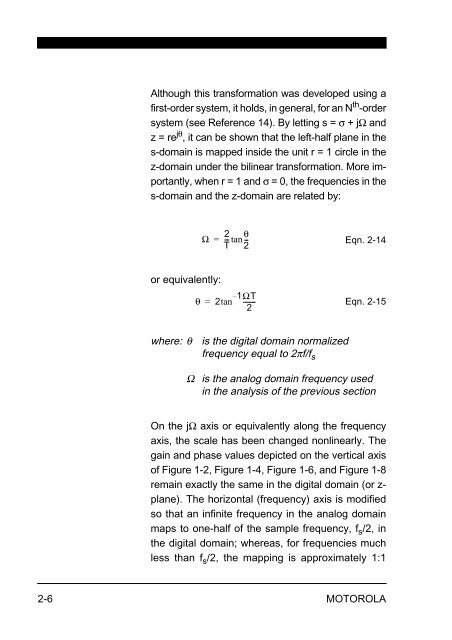Implementing IIR/FIR Filters
Implementing IIR/FIR Filters
Implementing IIR/FIR Filters
You also want an ePaper? Increase the reach of your titles
YUMPU automatically turns print PDFs into web optimized ePapers that Google loves.
Although this transformation was developed using a<br />
first-order system, it holds, in general, for an N th -order<br />
system (see Reference 14). By letting s = σ + jΩ and<br />
z = re jθ , it can be shown that the left-half plane in the<br />
s-domain is mapped inside the unit r = 1 circle in the<br />
z-domain under the bilinear transformation. More importantly,<br />
when r = 1 and σ = 0, the frequencies in the<br />
s-domain and the z-domain are related by:<br />
Ω<br />
or equivalently:<br />
2 θ<br />
= -tan-- T 2<br />
θ 2tan 1 – ΩT<br />
=<br />
-------<br />
2<br />
where: θ is the digital domain normalized<br />
frequency equal to 2πf/f s<br />
Eqn. 2-14<br />
Eqn. 2-15<br />
Ω is the analog domain frequency used<br />
in the analysis of the previous section<br />
On the jΩ axis or equivalently along the frequency<br />
axis, the scale has been changed nonlinearly. The<br />
gain and phase values depicted on the vertical axis<br />
of Figure 1-2, Figure 1-4, Figure 1-6, and Figure 1-8<br />
remain exactly the same in the digital domain (or zplane).<br />
The horizontal (frequency) axis is modified<br />
so that an infinite frequency in the analog domain<br />
maps to one-half of the sample frequency, f s /2, in<br />
the digital domain; whereas, for frequencies much<br />
less than f s /2, the mapping is approximately 1:1<br />
2-6 MOTOROLA
















